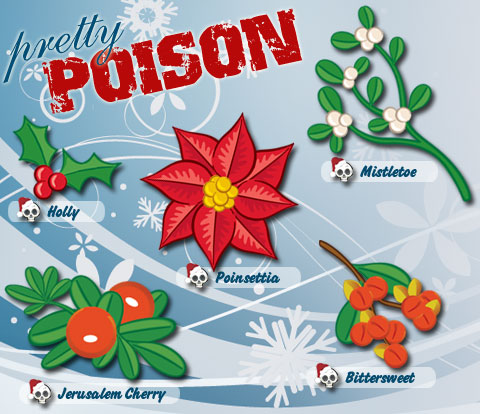The specialty food store was lined from the parking lot to the front door with bushy red poinsettias, fragrant wreaths of cedar or pine, and bunches of mistletoe. It was a veritable Christmas umbrage – a “green-carpet” leading into the store. I was overjoyed! The holidays and traditional foliage had arrived, including Christmas trees and holly garlands. Children scampered past paying little heed to the greenery lining their pathway and hands never failed to reach out, slapping at the nearest plant as the corner was turned. I began to wonder, where would that hand go next? Inside a mouth, most likely, came the answer.
Then horror struck and I began to wonder how many of these holiday plants so thoughtfully placed along the ground, eye level with and certainly within every child’s reach, were poisonous.
Christmas brings traditional plants associated with the holiday, not frequently seen during any other time of year. Several of these plants
can be dangerous if the adage, “look but don’t touch” isn’t followed. An assortment of these yuletide offenders are listed here (Poisonous Holiday Plants – Common Holiday Plants That Are Toxic or Poisonous Anne Marie Helmenstine, Ph.D.):
A List of Poisonous Holiday Plants
Poinsettia – I had always kept my plants up high, out of the reach of my children’s curious little hands mainly because I heard this one was the big, bad, dangerous Christmas plant. Apparently, my misgivings were overly dramatic because the poinsettia isn’t as bad as most on this list. Definitely a toxic plant that can cause abdominal distress if consumed or skin irritation if rubbed directly onto the skin, the poinsettia is beautiful – from a distance.
Mistletoe – To kiss under the mistletoe is one of the greatest traditions of the Christmas season. Fortunately, mistletoe is suspended overhead and rightfully so. Mistletoe comes in many varieties and contains toxins which can cause blurred vision, nausea, vomiting, blood pressure changes and death when taken internally. Berries from the mistletoe are just as dangerous and can be enticing to small children and animals. Best keep your mistletoe hung in the rafters.
Holly – This beautiful Christmas plant is used in almost every ornamentation and decoration in most households. Unfortunately, the beauty of this plant is deceptive as the berries, bark and leaves can cause serious illness, even death. The most interesting (even ironic) factoid about holly is that it contains a toxic chemical also found in chocolate – definitely deadly to animals.
Amaryllis – Once upon a time, my uncle gave me an amaryllis bulb for Christmas. I was delighted to watch as this fabulous blossom sprung forth with vibrant ruby pedals in the deep of the winter holiday. At that time I didn’t realize the Amaryllis is a common holiday gift which has bulbs that can be forced indoors to produce showy holiday flowers. Eating the bulbs (and leaves, though they are less toxic) can cause abdominal pain, cardiac arrhythmia, and convulsions. Amaryllis, daffodil, and narcissus are all plants which are best kept away from children and pets.
Of course, any time a child consumes plants that are not meant to be eaten in a salad or on the dinner plate, medical professionals should be consulted. Symptoms of poisoning can range from mild to violent illness and should never be ignored.
SureFire CPR in Orange County, California provides courses in Basic First Aid and CPR. Arming yourself with the knowledge and skill for intervention when an accidental poisoning occurs is the best Christmas present you can give. Contact SureFire CPR today and learn more about what you can do to Save a Life.










